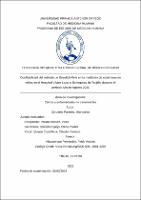Confiabilidad del método de Greulich-Pyle en la medición de edad ósea de niños en el Hospital Víctor Lazarte Echegaray de Trujillo durante el periodo Marzo-Agosto 2023
Abstract
OBJETIVOS: Determinar la confiabilidad del método de Greulich-Pyle en la
medición de la edad ósea en niños.
MÉTODOS: El diseño fue observacional, analítico de medidas repetidas,
pruebas diagnósticas, en el Hospital Víctor Lazarte Echegaray - Trujillo,
se evaluaron 30 Radiografías de mano izquierda de niños, mediante el
método de Greulich-Pyle, por 3 médicos entrenados y con cegamiento en
dos momentos separados por 1 semana, para determinar la confiabilidad
del método por la variabilidad inter e intra observadores.
RESULTADOS: La edad cronológica promedio es de 10.3 ± 3.11, siendo
19 (63.3%) del sexo masculino. La edad ósea promedio en el médico1-
médico2-médico3 fue de 10.46 ± 4.09, 10.73 ± 4.62, 10.28 ± 4.02, en la
primera observación y de 10.65 ± 4.13, 12.22 ± 4.43, 10.76 ± 4.17 en la
segunda observación; diferencias -0.18, -1.48 y -0.48 intraobservadores;
todas menores del 10%; aunque el Anova es significativo p=0.000; la
correlación de los hallazgos es significativa con un Pearson de 0.974,
0.854 y 0.979 respectivamente p=0.000 en los 3 casos. El alfa de
Cronbach del método de Greulich-Pyle de las diferencias en las medias
entre sujetos siempre son menores del 10%, Anova intersujetos con
p=0.000. El Coeficiente alfa de Cronbach es de alta fiabilidad =0.984 y el
de correlación intraclase es 0.909. Los niveles de acuerdo son de 60%-
50%, 73.3-70%, 46.6%-53.3% entre Med1-Med2 (O1-O2), entre Med1-
Med3(O1-O3) y entre Med2-Med3(O2-O3) respectivamente. El
coeficiente Kappa de acuerdo entre observadores para edad ósea
patológica es de 0.437 con p=0.013.
CONCLUSIONES: El método de Greulich-Pyle tiene alta confiabilidad
para estimar la edad ósea en niños OBJECTIVES: To determine the reliability of the Grewlych-Pyele method in the
estimation of bone age in children.
METHODS: The design was observational, analytical of repeated measures,
diagnostic tests, at the Hospital IV Lazarte - Trujillo, 30 left hand X-rays of children
were evaluated, using the Greulych Pyle method, by 3 trained and blinded
physicians at two times separated by 1 week, to determine the reliability of the
method by inter- and intra-observer variability.
RESULTS: The mean chronological age was 10.3 ± 3.11, with 19 (63.3%) being
males. The mean bone age in the medical1-medical2-medical3 pair was 10.46 ±
4.09, 10.73 ± 4.62, 10.28 ± 4.02, in the first observation and 10.65 ± 4.13, 12.22
± 4.43, 10.76 ± 4.17 in the second observation; differences -0.18, -1.48 and -0.48
intraobserver; all less than 10%; although the anova is significant p=0.000; The
correlation of the findings is significant with a Pearson of 0.974, 0.854 and 0.979
respectively p=0.000 in the 3 cases. The Cronbach's alpha of the Greulich-Pyle
method is of the differences in the means between subjects are always less than
10% intersubject Anova with p=0.000. The Cronbach's alpha coefficient is highly
reliable =0.984 and the intraclass correlation is 0.909. Agreement levels are 60%-
50%; 73.3-70%; 46.6%-53.3% between Med1-Med2 (O1-O2), between Med1-
Med3(O1-O3) and between Med2-Med3(O2-O3) respectively. The Kappa
coefficient of agreement between observers for pathological bone age is 0.437
with p=0.013.
CONCLUSIONS: The method Grewlych-Pyle has high fiability to estimate bone
age in children
Subject
Collections
- Medicina Humana [2969]


